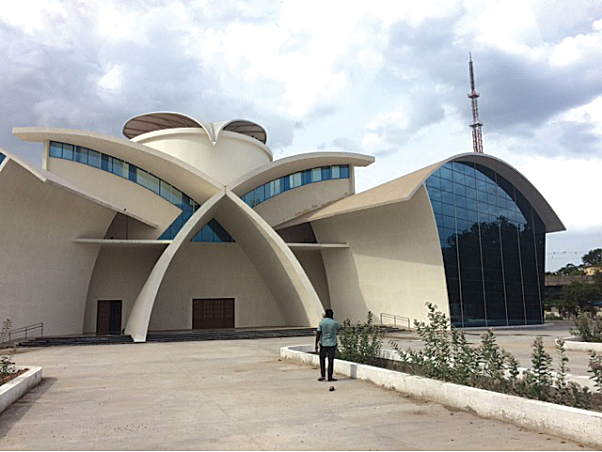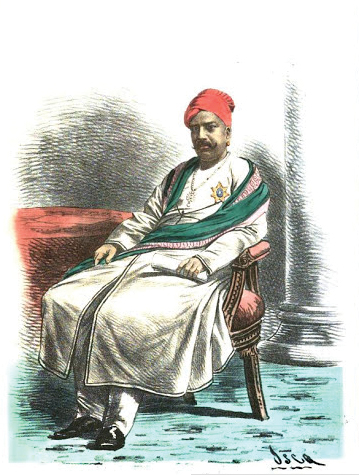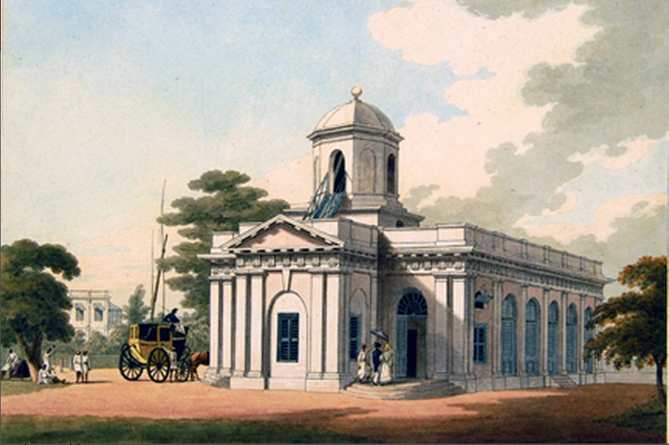Registered with the Registrar of Newspapers for India under R.N.I 53640/91
Vol. XXVII No. 8, August 1-15, 2017
Archives: Vol. XXVII No. 8, August 1-15, 2017
Tasteless mimicry in heritage area
by A Special Correspondent

The new State VIP Guest House mimicking the Sydney Opera House.
An addition to the architectural landscape of Chennai is a structure that has emerged in Government (Omandurar) Estate, next to the new Kalaivanar Arangam, to serve as State VIP Guest House. The elevation is touted as having been modelled on the world renowned Sydney Opera House, abutting the Sydney harbour in Australia!
The entire erstwhile Government Estate, called the Omandurar Estate, now has many new structures, of course, dominated by the mammoth fortress-like structure originally meant to house the Secretariat but subsequently made by a successor government into a multi-speciality hospital.
To heritage lovers and nostalgic Chennai residents, the Secretariat-now-hospital building has been cause for disappointment – not over the public purpose that it serves but over the insensitivity of putting up a building of such monstrous proportions in a historical spot, a prime location in South India. It is of a design devoid of art and grace and totally at variance with colonial style buildings and historical structures of Indo-Saracenic architecture in the neighbourhood. To some extent, the new Kalaivanar Arangam has attempted to incorporate ancient temple style and Dravidian architectural features to keep up with the cultural character of this area.
The latest addition is a purposeless, swanky, pathetic imitation of the Sydney Opera House. Imitations never become the equivalent of the original. They only invite derisive comparisons. Why this incongruous imitation in an area where enough architectural inspiration is available from the Khalsa Mahal, the Humayun Mahal, and the old colonial buildings in the neighbourhood?
Heritage conservation through restoration and protection of ancient structures and their sites is only one aspect. When several major heritage structures and styles are predominant in an area – as in the Estate area – the neighbourhood is endowed with a heritage atmosphere and character acquired over several generations through history. As such, heritage neighbourhoods need to be defended as much as specific structures and sites.
Govt. trying to kill our waterways?
By The Editor
On paper it is all there – our State is committed to protecting its waterways. It is forever in river-cleaning mode, spending billions of taxpayers’ money for this and all the while its own agencies, departments and undertakings continue to pollute and impede the rivers as much as they can. This is the feeling that you get when you read the recent orders of the National Green Tribunal (NGT) when it came down heavily on State-owned power utilities for continuing to pollute the city’s waterways.
It was in June that the NGT had first taken note of the continued pollution of the Buckingham Canal and the Kosasthalayar River, chiefly by the indiscriminate dumping of fly ash by the TANGEDCO-controlled North Chennai Thermal Power Station (NCTPS). The offending Government department had been asked to dredge the rivers and remove all the debris. This was duly done. But immediately thereafter, the NCTPS resumed discharging of fly ash into the rivers. According to environmental activists, over 300 acres of the Ennore Creek area are now covered by fly ash and other debris. Incensed at this, the NGT has asked the NCTPS to stop the discharge of ash within a week or face closure of the plant in entirety.
Even in the 1700s, Book clubs were really about drinking and socialising
by Sarah Laskow

Parties where playwrights like Moliere read aloud were precursors to rowdy book clubs. ULLSTEIN BILD/GETTY
A Madras Book Club member who regularly scans the web, sends us this feature saying, “It could well apply to our Club too”.
In theory, book clubs are supposed to be about reading and dis-cussing books. In practice, they are often more about hanging out with a group of people, drinking, gossiping, and generally having a nice evening. Depending on the percentage of the group that has actually read the book, it may be discussed, or it may not. The book is the excuse, not necessarily the point. It turns out it’s always been this way.
Ever since the advent of book clubs in 18th Century England, when books were scarce and expensive, these organisations have been about more than reading. Book clubs were organised to help members gain access to reading material and to provide a forum for discussion of books the clubs held. But they were also about gossip and drinking. As the University of St. Andrews’ David Allan writes in A Nation of Readers, “In most cases, food and alcohol in copious quantities, accompanied we may suspect by a considerable element of boisterous good humour, played an important part in the life of the book clubs.”
CHARIVARI – 4
Sriram V
THREE TIMES A DEWAN

The Indian Charivari series does not include many Indians, its attention being largely on colonial administrators. Among the few who made it is Tanjore Madhav Rao. He could clearly not be overlooked, for his record, when the Charivari was under preparation, was nothing short of trailblazing. He had just then completed his tenures as Dewan of two princely states – Travancore and Indore – and was embarking on the third – Baroda. And none of these was placid tenure. In each case, he took over a State that was in a shambles and by the time he left, they were upheld as models of administration.
Lost landmarks of Chennai
Sriram V
Kerr’s Church that Goldingham built
(Continued from last fortnight)

Julius Gantz’s engraving of the church Goldingham built.
Even though the Government had readily agreed to part funding a chapel in Black Town, there were some murmurs that the salary of a regular pastor would be a continuing charge. Kerr allayed these fears stating that he would minister to the parish free of cost and that this would be in addition to the time he spent at the Church of St. Mary’s in the Fort. John Goldingham, Government Astronomer, who would later design the Banqueting (Rajaji) Hall, planned the church and work began in 1798. It was completed a year later and on the first Sunday of 1800, the Rev. Kerr delivered the first sermon there. He would minister to the devout here every evening thereafter until his passing, except when he was away from the city or was unwell.

